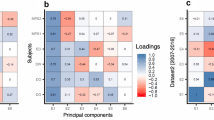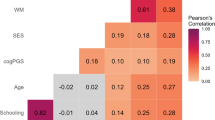Abstract
THE few studies1,2 in which the effects of inbreeding on cognitive performance have been examined revealed that offspring of first-cousin marriages had lower IQ scores than offspring of unrelated parents. These studies were, however, performed in societies where the population engaging in such marriages is a small (1%, 6%)2,3 and unrepresentative proportion of the total population. Possible confounding of the effects of inbreeding with the effects of other intelligence-related variables such as socioeconomic status may lead the effects of inbreeding to be overestimated2. Unfortunately statistical control may either over- or under-correct for the correlates of the independent variables, leaving one in doubt about the true effect of inbreeding. I have now examined the effects of inbreeding on cognitive performance in an Arab population with a high rate of consanguinous marriage which minimised the distortions due to non-genetic variables. I show here that offspring of unrelated parents performed better than offspring of first-cousin marriages in intelligence and achievement tests administered at grades 4 and 6. The lowest level of performance and a higher variance were found for offspring of double-cousin marriages. The inbreeding depression found in this study is consistent and cannot be explained by the effects of socioeconomic status. I drew a nationally representative sample of 3,203 children in grades four and six (approximate ages 10 and 12 yr) of the Arab educational system in Israel. This sample constitutes about 10% of the total population in these grades and includes only normal (not retarded) children. Column 1 in Table 1 shows the division of the subjects according to grade level and consanguinity of the parents. A first-cousin marriage is between children of siblings. Children of first cousins have, on average, 1/16 pairs of genes by common descent. Double first cousins are children of siblings married to unrelated siblings. When they marry, their children have, on the average, 2/16 pairs of genes by common descent.
Similar content being viewed by others
References
Cohen, T., Block, N., Flum, Y., Kadar, M. & Goldschmist, E. in E. Goldschmist (ed.). The Genetics of Migrant and Isolated Populations (Williams & Wilkins, Baltimore, 1963).
Schull, W. J. & Neel, J. V. The Effects of Inbreeding on Japanese Children. (Harper and Row, New York, 1965).
Sterm, C. Principles of Human Genetics (Freeman, San Francisco and London, 1960).
Campbell, D. T. & Boruch, R. F. in Evaluation and Experience: Some Critical.(Issues in Assessing Social Programs (eds Lumsdaine, C. A. & Bennett, C. A.) Academic, New York, 1957).
Cavalli-Sforza, L. L. & Bodmer, W. F. The Genetics of Human Populations(Freeman, San Francisco, 1971).
Raven, J. C. Guide to the Standard Progressive Matrices. (Lewis, London, 1960).
MacLean, C. J., Morton, N. E. & Lew, R. Am. J. hum. Genet., 27, 365–384 (1975).
Morton, N. E. Am. J. hum. Genet. 26, 318–330 (1974).
Author information
Authors and Affiliations
Rights and permissions
About this article
Cite this article
BASHI, J. Effects of inbreeding on cognitive performance. Nature 266, 440–442 (1977). https://doi.org/10.1038/266440a0
Received:
Accepted:
Published:
Issue Date:
DOI: https://doi.org/10.1038/266440a0
- Springer Nature Limited
This article is cited by
-
Associations of autozygosity with a broad range of human phenotypes
Nature Communications (2019)
-
Genomic analysis of family data reveals additional genetic effects on intelligence and personality
Molecular Psychiatry (2018)
-
Song learning and cognitive ability are not consistently related in a songbird
Animal Cognition (2017)
-
Genome-wide autozygosity is associated with lower general cognitive ability
Molecular Psychiatry (2016)
-
Genetics and intelligence differences: five special findings
Molecular Psychiatry (2015)





